#Panthera tigris amoyensis
Explore tagged Tumblr posts
Text

South China Tiger for a $15 Ko-fi supporter
#art#my art#digital#digital art#clip studio#clip studio paint#csp#illustration#doodle#request#kofi doodles#kofi request#kofi#ko-fi#tiger#south china tiger#Panthera tigris tigris#Panthera tigris amoyensis#lazert#lazer-t#feline#big cats
1K notes
·
View notes
Text
Simba Tiger says, "GOODNIGHT, Big Cat Friends!"
Can you name all the subspecies of tigers?
Do you know how many subspecies of tiger are extinct?
It is time for us to all get busy learning about ways to prevent the extinction of any more subspecies of tigers. Are YOU ready to learn? Learning will be the first step to helping save the tiger in the wild, where it belongs.
Bengal Tiger – Panthera tigris tigris 1200-1500 left
Siberian (Amurian) Tiger – Panthera tigris altaica 331 left
Sumatran Tiger – Panthera tigris sumatrae 136 left
Indo-Chinese Tiger – Panthera tigris corbetti
Malayan Tiger – Panthera tigris jacksoni **
South China Tiger – Panthera tigris amoyensis 37 left
Javan Tiger – Panthera tigris sondaica ��� extinct since early 1980’s
Bali Tiger – Panthera tigris balica – extinct since the 1940’s
Caspian Tiger – Panthera tigris virgata – formerly thought to be extinct since the early 1970’s *
#cat#cats#species#endangered#savethetiger#savethetigers#facts#extinction#extinctionisforever#extinct#tiger#tigers#simba#animaleducation#caspian#bali#javan#southchinatiger#sumatran#siberian#bengal#bigcats#BigCatRescue
9 notes
·
View notes
Text
harimau

Harimau (Panthera tigris) adalah spesies kucing besar yang sangat ikonik, dikenal karena bulunya yang bercorak loreng hitam di atas dasar oranye kecoklatan, serta perannya sebagai predator puncak di banyak ekosistem Asia. Harimau adalah hewan yang kuat, soliter, dan territorial, hidup di berbagai habitat seperti hutan tropis, savana, dan rawa-rawa. Ada beberapa subspesies harimau, termasuk:
Harimau Benggala (Panthera tigris tigris): Subspesies paling umum, terutama ditemukan di India, Nepal, Bhutan, dan Bangladesh.
Harimau Sumatera (Panthera tigris sumatrae): Subspesies terkecil, ditemukan di Pulau Sumatera, Indonesia. Sayangnya, populasinya sangat terancam punah.
Harimau Siberia (Panthera tigris altaica): Juga dikenal sebagai Harimau Amur, subspesies ini ditemukan di daerah dingin Rusia timur jauh, Korea Utara, dan Cina timur laut.
Harimau Indochina (Panthera tigris corbetti): Ditemukan di wilayah Indochina, termasuk Thailand, Kamboja, dan Laos.
Harimau Malaya (Panthera tigris jacksoni): Hidup di Semenanjung Malaysia.
Harimau Cina Selatan (Panthera tigris amoyensis): Sangat terancam punah, diperkirakan telah punah di alam liar.
0 notes
Text
South China Tiger: A Species on the Brink
In the dense forests and rugged landscapes of China, there once prowled a majestic predator, the South China Tiger (Panthera tigris amoyensis). Revered in Chinese culture as the king of the mountains, this magnificent feline once roamed across the southern regions of China, from the foothills of the Himalayas to the dense forests of Guangdong and Fujian provinces. However, today, the South China…

View On WordPress
0 notes
Text

South China Tiger
Panthera tigris amoyensis
Source: Here
#south china tiger#china#tiger#tigers#feline#felines#cat#cats#big#big cat#big cats#animal#animals#wildlife#nature
131 notes
·
View notes
Photo
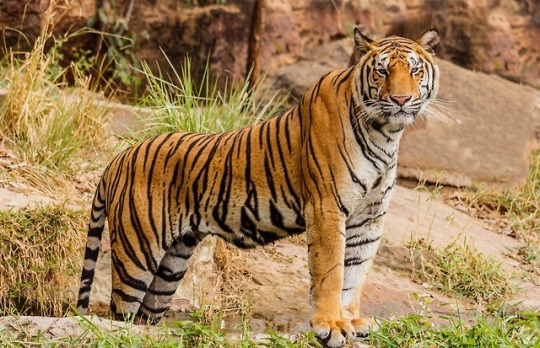
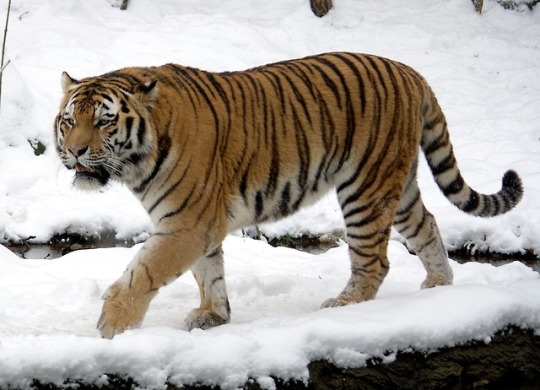
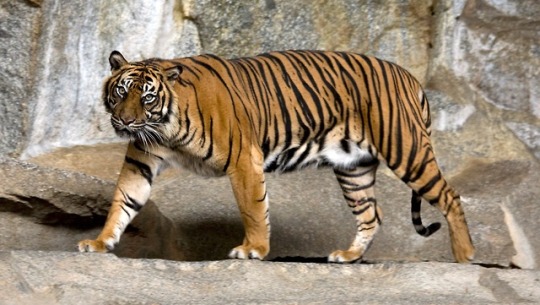
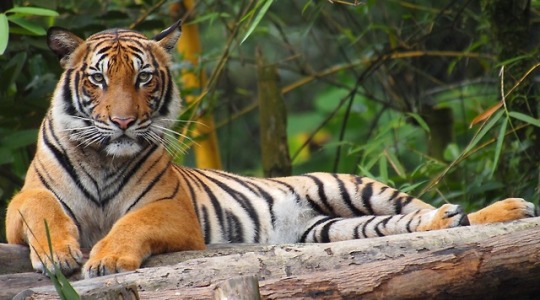
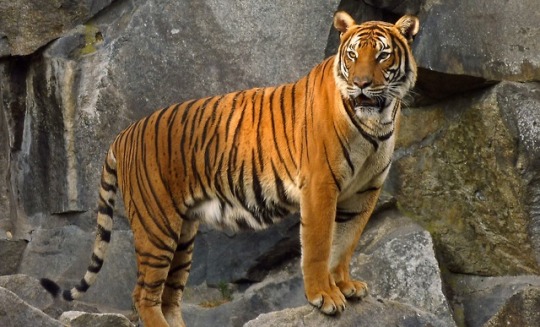

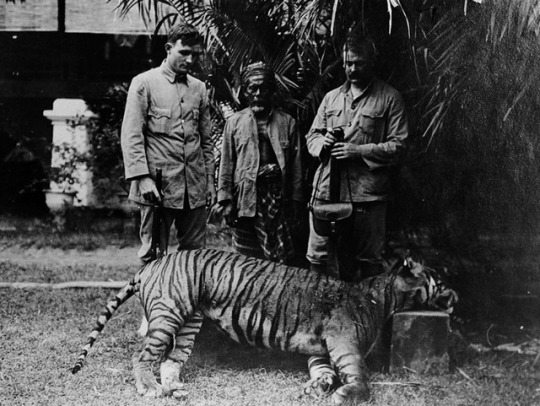
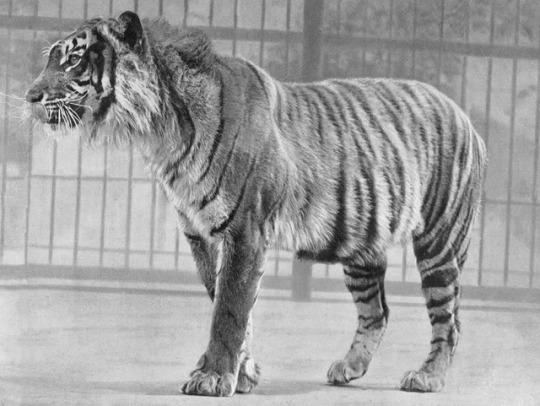

Endangered Felines, part 1
Tiger, Panthera tigris
Without a doubt one of the most iconic and recognizable animals on Earth, the tiger was voted the world’s favorite animal in 2004, with the domestic dog coming in second, and dolphins third.
I was planning on splitting tigers into one post per subspecies, but since there are sadly so many cat species that are endangered, this series will be long enough already, and it gives a better overview to have them all in one post.
And just as I was researching for this post, it turns out that in 2017, the tiger was reduced to a mere two subspecies - the mainland (P. t. tigris), and the Sunda Island (P. t. sondaica) populations - but this is disputed, as there are morphological and genetic differences between these populations. In this post, I will treat them all as their own subspecies.
While at first I was a bit skeptical about the switch to now only having two tiger subspecies when I think about it more, it's actually great for tiger conservation, because that means we don't have to be "subspecies purists" anymore. This means we can repopulate areas with another population easier, without claims of "it's an invasive/foreign animal".
While I will try to keep each topic brief, this will still be a lengthy and exhaustive post, as you can’t simply brush over things in the most beloved and famous endangered animal on Earth.

This is the historic range of all tigers. From the far northeast of Russia to the east of the Black Sea, by Georgia, Armenia and Azerbaijan, all the way to the far southern islands of Java and Bali.
Today, they have been extirpated from most of their range, with three of the nine former subspecies extinct. By 2017, there were just under 4000 tigers in the wild combined, and that is after a recent rise in numbers, for the first time in over a century. A couple of hundred years ago, there were at least 40 000 tigers in India alone.
They are estimated globally to have numbered around 100 000 in the year 1900, meaning 97% of tigers were lost in a century.
Occasionally hunted throughout history, either because of fear, sport among the wealthy or for their parts, tiger hunts took on a new dimension when Europeans colonized India and other parts of South Asia, with "gentlemen sports hunters" proudly subduing nature. And later in the 20th and 21st centuries, mainly poaching for body parts used in "traditional medicine".

An Indian tiger hunt carried out by Lord Reding, Viceroy of India, likely in the mid-1920s.
Direct hunting is not the only threat against tigers, as the human population in Southeast Asia has exploded over the past century, and today, there is nowhere left for wildlife to go.
The tiger has been listed as endangered under the IUCN, consistently since its first assessment in 1986.
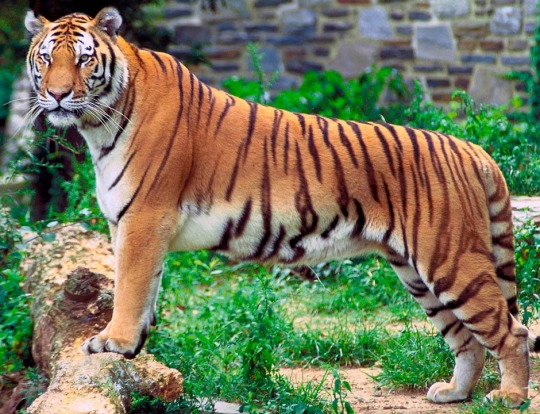
Bengal tiger, Panthera tigris tigris
The Bengal is without a doubt the most well-known of all tiger subspecies, not the least due to our strong association of tigers with Indian culture. They are also the most numerous tiger population today.
They are 90-110 cm tall at the shoulders and weigh up to 325 kg, with males averaging 235 kg, and females ranging from 116-164 kg.
Given a separate assessment by the IUCN in 2008, the Bengal tiger is considered endangered. Today, they number around 2300 animals in the wild, 1700 of which are in India, 440 in Bangladesh, 200 in Nepal, and 75-100 in Bhutan.
The population is severely fragmented, and no subpopulation contains more than 250 animals. Despite cautiously optimistic news a couple of years ago, they are still considered "decreasing".
If 40 000 was the original number of tigers in India, today, there are only 4% left, and it is still the biggest stronghold of wild tigers anywhere.
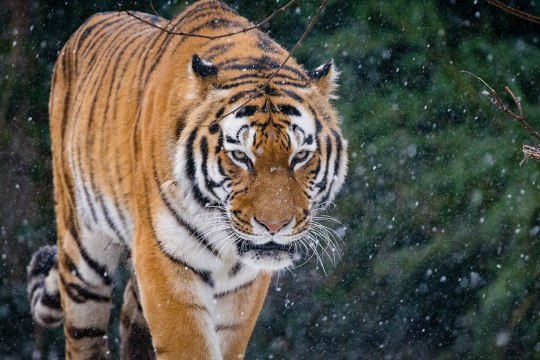
Amur tiger, P. t. altaica
More famously known as Siberian tiger, this name is inaccurate as they don't live anywhere near Siberia, which is a large chunk of eastern Russia, having no eastern coastline. While the tiger lives in the very far southeast, near Korea. They are also known as the Manchurian, Ussurian and Korean tiger.
As can be seen on the map above however, they did have a far larger range before widespread hunting nearly wiped them out.
The largest cat on Earth today (after the extinction of the Caspian tiger), they are the second most numerous tiger population, at around 500 animals in the wild (in 2005, they were estimated at 360). They were saved on the brink of extinction, as only a couple of dozen animals remained when they were finally protected.
Despite this vast increase however, the effective population size is only equivalent to around 30 animals, which is close to the total world population when they were saved from extinction. This is due to inbreeding from a smaller and smaller population that then had only a handful of already related animals to rebound from.
It was in the early 20th century that the Amur tiger was nearly wiped out, due to the massive societal change that was going on in Russia at the time. Armies on both sides of the civil war based in Vladivostok made it their mission to kill as many tigers as they could.
Tigers were extirpated from the Korean peninsula by the Japanese in the same period, when Japan occupied Korea. Today, South Korea is working on once again creating a home for the Amur tiger in their lands.
The Soviet Union finally banned tiger hunting in 1947, after which anti-poaching control was very strict. Cubs kept being live-caught well into the 1960s however.
In the middle of the 1900s, deer populations fell in the Amur tiger's range, leaving them no choice but to find other prey. Bizarrely, more than 30 cases of tigers attacking bears were recorded, and bear hair was found in tiger droppings.
After the fall of the Soviet Union in 1991 and the subsequent economic and societal collapse, people were free to poach tigers again, with some doing it to sell to the Chinese market. Today however, the population is stable, but vulnerable.
In 1965, it was given the listing of "status inadequately known", and this was not changed until 1996, when they were assessed as "critically endangered". This laster until 2008, when they were moved to endangered.
At present, there are about as many Amur tigers in human care as there are in the wild, totalling about 1000 Amur tigers on the planet. The zoological population has a higher genetic diversity than wild tigers, as the foundation stock was largely caught when tigers were more numerous in the wild.

Sumatran tiger, P. t. sumatrae
The Sumatran is the one tiger that I personally can recognize easily, due to their striking and bold facial pattern. They are among the smallest tigers alive today, with males reaching only 140 kg - this is a size similar to jaguars. They are also the only Indonesian or Sunda island tiger still in existence.
The Sumatran tiger has been consistently listed as critically endangered since their first assessment in 1996.
They number approximately 500-600 animals, not including ones in zoos and other collections.
Their threats are mainly a shrinking habitat due to palm oil and Acacia plantations leading to a depletion of prey, as well as poaching for their body parts.
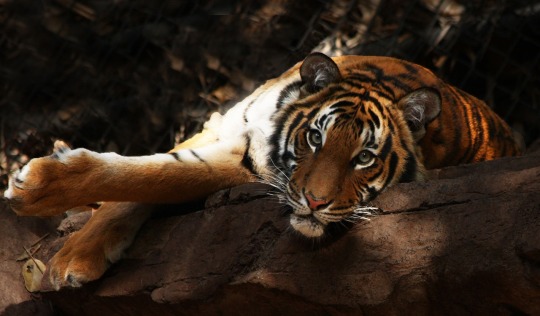
Malayan tiger, P. t. jacksoni
Although recent research has discovered that there is no real difference between this and the Indochinese tiger, it was considered its own subspecies since a DNA analysis in 2004, until the recent merge where all mainland tigers are considered P. t. tigris.
Subspecies or subpopulation, the Malayan tiger was listed as “endangered” in 2008, and in 2014, it was reassessed under its current listing as critically endangered.
This was because they had declined by 25% in only one generation (7 years).
In the 1950s, there were about 3000 Malayan tigers. In the 1990s, there were 500, and in 2013, they were estimated at 250-340 animals. This gives an estimate of only around 100 breeding adults in the wild.
The total number in human care is difficult to get to, but apparently in 2011, there were 54 Malayan tigers in American zoos alone, spread across 25 facilities.
The Malayan tiger's habitat has shrunk from nearly 100 000 square kilometers before 1970s, to less than 45 000 square kilometers in 2014. Aside from this threat, is of course poaching for body parts for a Chinese market. Between the years 2000-2013, body parts equating to 1425 tigers had been seized, 94 of these being Malayan tigers.
The Global Tiger Recovery Program, made up of 13 countries where tigers live, set a goal in 2010 to double their tiger populations by 2022. Malaysia had made a similar promise before this agreement, in 2009, with their National Tiger Conservation Action Plan setting to doubling Malaysia's tiger population by 2020.
With the new population estimate of 250-340 adult Tigers and diminishing prey base and natural forests, it is biologically impossible to reach the NTCAP target by 2020.
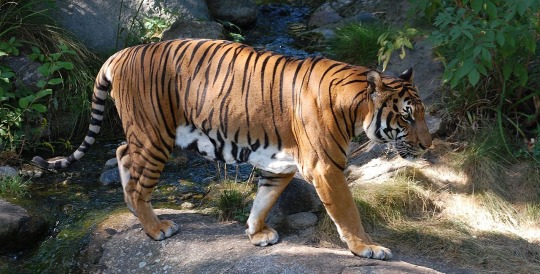
Indochinese tiger, P. t. corbetti
The Indochinese tiger lives in Southeast Asia, and is viewed as the ancestor of all tigers, the other subspecies diverging around 72 000-108 000 years ago.
They are functionally extinct in Vietnam, Cambodia and possibly China, and number around 300-400 animals in total, the largest population being in Thailand.
They have been listed as endangered since 2008.
They are the least represented in zoos out of all tiger subspecies, and no coordinated breeding program exists. Approximately 14 zoo tigers have been discovered to be Indochinese after DNA analysis of 105 animals in 14 countries.
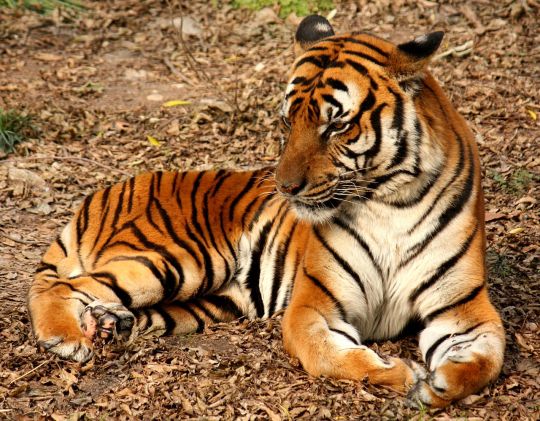
South China tiger, P. t. amoyensis
This is the most threatened tiger subspecies as they are believed to be extinct in the wild, since the last time one was live-caught in the 1970s.
Only 20 years earlier, they numbered more than 4000 animals, but then came Mao Zedong's "Great Leap Forward", when all wildlife stood in the way of "progress" (remember the Baiji).
Large-scale government anti-pest campaigns took off, and tigers were massacred, mercilessly. This was made worse by deforestation, heavy settling of the countryside from the cities (as part of the GLF) and over-hunting of their prey.
By 1973, they were partially protected, and by 1977, hunting was completely prohibited.
By the early 1980s, they were estimated at 150-200 animals, though not one tiger has been seen since the early 70s.
They are considered critically endangered, possibly extinct in the wild, but there is hope there still are a handful of tigers holding on in the wilds of China. For example, in 2007, a bear and a cow were killed by what was most likely a tiger.
In 2005, the entire zoological population numbered 57 animals descended from only six tigers. Despite being inbred and suffering poor breeding success as a result, DNA tests showed many aren’t pure South China tigers anyway. Another estimate (made difficult by crossbreeding) in 2007 put the global zoological population at 72 animals.

Bali tiger, P. t. balica
The Bali tiger, formerly inhabiting only the island of Bali since 12 000 - 13 000 years back, was the smallest of all tigers, with males only reaching up to 100 kg and females 80 kg, putting this tiger around the same size as a jaguar or cougar.
They were only listed as extinct by the IUCN as late as 2008, but the last one probably died just after the second world war, with the last known tigers recorded in the 1930s.
The Bali tiger was killed off through a lethal cocktail of environmental destruction (palm plantations and rice fields) and sports hunting by the Dutch colonizers. The West Bali National Park was established in 1941, but it came too late to save the tiger.
This animal was never filmed alive nor held in zoos (though it seems the Ringling Bros Circus had one), and it is very difficult to even find photos of live animals.

Javan tiger, P. t. sondaica
The Javan tiger was small, but just larger than the Bali, and similar in size to the still living Sumatran. They were notable in appearance by often having very sparse stripes around the front legs and shoulders.
This population was pronounced extinct by the IUCN in 2003, but the last confirmed sighting was recorded as far back as 1976. Several accounts of alleged sightings exist however, even within the last ten years, including a person supposedly being killed by a tiger in 2008.
In 2017, a blurry image surfaced of what was supposedly a Javan tiger. It was however most likely a Javan leopard, also a critically endangered cat.
We can always hope at least some of these alleged sightings were of tigers, but there is always the possibility that the animals witnessed were actually leopards.
At the turn of the last century, 28 million people lived on Java, while today, it is a jaw-dropping 145 million (resulting in a mind-blowing population density of 1.121 people per square kilometer - in comparison, the state of New York has a population denity of 416 people per square kilometer).
By the middle of the 1800s, people considered tigers a plague, and by the turn of the century, 150% more land had to be cleared for agriculture in only 15 years. By 1975, only 8% of the island's forests remained.
These tigers were poisoned, hunted, their main prey nearly died out, and the forests were cleared for lumber and agriculture.
To make things even worse, World War 2 happened, so the few that were kept in zoos were lost. After the war, it was easier to obtain Sumatran tigers, so none were taken from Java.
A funny thing to note is how the Javan people’s fear of the tiger led them to always referring to it as “Mr. Tiger”. They thought that if they spoke of it in a casual way, the tiger might hear them and take revenge.
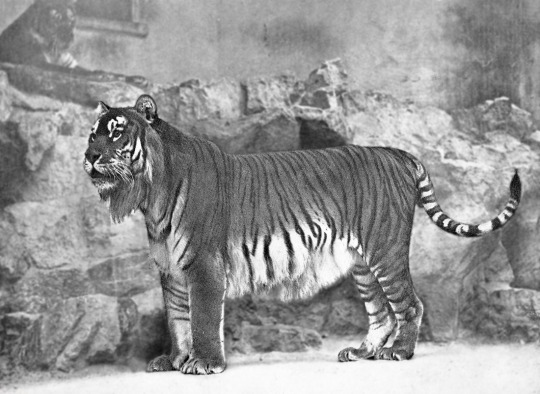
Caspian tiger, P. t. virgata
Like the Javan tiger, the Caspian was pronounced extinct by the IUCN in 2003, but the last record was in the early 1970s, and it died out some time during this decade.
It was possibly the largest cat in the world during recorded human history, after the ice age extinction of the cave lion.
It lived across parts of Georgia, Armenia and Azerbaijan, eastern Turkey, northern Iran, parts of Uzbekistan, Afghanistan, Turkmenistan, Kazakhstan, Kyrgyzstan, Tajikistan, even well into western China.
The last tiger in Georgia was shot in 1922, they were last recorded in Kazakhstan in 1948, one of the last in Iran was shot in 1953, the last in Turkmenistan was killed in 1954.
Tigers were killed both for sport and as pest control, including by the Soviet army. Up until World War 1, about a hundred tigers were killed in a forest area of the Afghanistan-Tajikistan border - every year. To make matters worse, their natural prey (pigs) declined heavily in the early 1900s due to overhunting and disease, and agriculture destroyed much of the tiger's natural habitat.
While this unique population is gone forever, there are plans to perhaps one day restock the area with Amur tigers, the closest living analogue to the Caspian tiger.
In a day when habitats are shrinking, other habitats may open up, and this could give the Amur tiger a greater hope to continue into the future.
The “there are more tigers in people’s backyards / basements than in the wild”-myth
More of a misrepresentation than a myth, it is true that there are more tigers in human care across the globe than there are in the wild. This is nothing strange for such an endangered animal.
The Scimitar-horned oryx, for example, was up until a couple of years ago extinct in the wild. There are now a few dozen roaming completely wild, while there are up to 11 000 of the antelopes in Texas alone.
The Eastern Bongo numbers around 400 animals in American collections alone, four times the population remaining in the wild!
The Przewalski's horse numbers around 2000 animals, and although many live in free-ranging reserves, only around 400 are considered truly wild and living in their native habitat, after reintroduction programs.
The Père David’s deer was extinct in the wild until some animals escaped and formed a population now some 700 strong, but it's still far outnumbered by the zoological population.
The blue-throated macaw numbers only around 300 animals in the wild, and the World Parrot Trust previously said there were "up to a thousand" in cages.
The Spix’s macaw numbers around 130 birds in human care, and was considered extinct in the wild since the last known bird disappeared in 2000, until one was discovered in 2016. If there are more in the wild, it is only a handful of scattered individuals.
The Hawaiian crow is extinct in the wild since 2002, with just over 100 birds in human care.
The Socorro dove has been extinct in the wild since 1972, with 150 birds alive today, all in cages.
The Guam rail is extinct in the wild since 1987, with some 160 birds alive in zoological facilities.
The orange-bellied parrot numbers around 340 in human care, with less than 20 in the wild.
It is however not true that there are more tigers in America than in the wild, let alone "in people's basements".
That claim is completely absurd, and while sometimes tigers are abused and neglected as with all animal species, that is extremely rare and would be far more common in their native Asia than in America.
According to the Feline Conservation Federation, the United States held just under 2900 tigers in 2011. In contrast, a decade ago in China, there were over 4000 tigers in human care in that country alone. The IUCN states (unknown date) that there are some 6000 tigers in China, mainly farmed for body parts.
We can debate the ethics of these various tiger facilities, but a large number also live in zoos and conservation centers. There is no such thing as several thousand "pet tigers" living in people's living rooms, backyards, or basements.

Privately owned tigers in America, courtesy of the Feline Conservation Federation.
But what the popular media likes to do, other than misrepresent the numbers (and say there are "10 000 pet tigers in American backyards" or some such nonsense), they also like to say that it's this vast number in human care ("captivity") that is the problem!
When people hear for example that there are 3000 tigers in the wild and 5000 or something in America, they seem to think America "stole" those tigers from the wild, and they must be put back! While in reality, tigers in the west have spent decades and generations on the continent, in zoos, circuses, and private collections.
And if you could take America's 2900 tigers and release them all, say hypothetically that it was allowed (many are not "pure") and that they could all survive in the wild. The threats on tigers in the wild, from poaching and habitat destruction, is still nowhere near gone.
So then we could have 5900 tigers for a while, and then a decade or two later, we'd be right back at 3000 again, with NOT ONE tiger alive in American breeding programs. Now who would that help?
That there are more tigers in human care than in the wild is a tragedy of the wild, not of "captivity".
In conclusion
Tigers are the most beloved endangered animal on the planet, and given both their popularity as well as their comparatively vast numbers in human care, the species stands a good chance at surviving indefinitely.
Whether that will only be in zoos, farms and other collections for the foreseeable future, or whether our children and grandchildren will have a chance to see tigers roaming freely in their natural habitats, free from persecution, is another question.
http://www.iucnredlist.org/details/15955/0
https://wildfact.com/forum/topic-on-the-edge-of-extinction-a-the-tiger-panthera-tigris?page=17
https://www.theguardian.com/uk/2004/dec/06/davidward
http://www.prweb.com/releases/2011/9/prweb8805806.htm
http://www.prweb.com/releases/2011/9/prweb8840075.htm
https://blog.nationalgeographic.org/2015/02/21/is-extinct-forever-central-asias-caspian-tiger-traverses-the-comeback-trail/
https://www.inverse.com/article/26481-caspian-tigers-extinct-central-asia-amur-kazakstan
https://asiancorrespondent.com/2018/04/south-korea-to-open-asias-largest-tiger-forest/
#Endangered Felines#tiger#Bengal tiger#Amur tiger#Siberian tiger#Sumatran tiger#Malayan tiger#Indochinese tiger#South China tiger#Bali tiger#Javan tiger#Caspian tiger#extinct animals#poaching#deforestation#Big Cat Rescue#BCR#pet tigers#pet tiger#exotic pets#Feline Conservation Federation
31 notes
·
View notes
Text
The Magnificent Seven Endangered Wild Cats
The Magnificent Seven Endangered Wild Cats
SOUTH ARABIAN LEOPARD-MOTHER AND CUB West African lion(Panthera leo senegalensis) – Critically Endangered South China tiger(Panthera tigris ssp. Amoyensis) – Critically Endangered – Possibly Extinct in the Wild Sumatran tiger(Panthera tigris ssp. sumatrae) – Critically Endangered Amur leopard(Panthera pardus ssp. orientalis) – Critically Endangered Javan leopard(Panthera pardus ssp. melas) –…

View On WordPress
0 notes
Text
Endangered Animals In China
The Himalayan Brown Bear
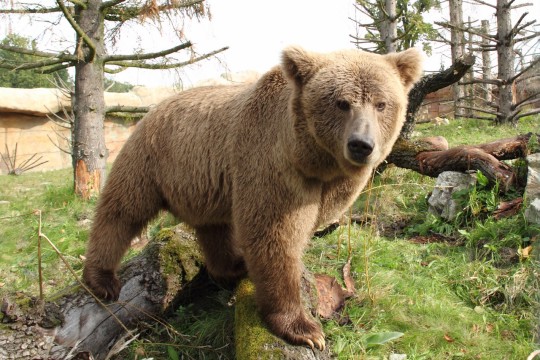
Himalayan Brown Bears (Ursus Arctos Isabellinus) are species of brown bears.
Their colours are sandy or reddish-brown.
They commonly live at the mountains of Afghanistan, Pakistan, Northern India, West China, Nepal, Kazakhstan and Tibet.
Male bears are about 4 feet and 11 inches ro 7 feet to 3 inches while female bears are 4 feet and 6 inches to 6 feet tall.
LIke regular bears, the Himalayan Brown Bears use their strong front legs for running at the speed of 35 mph and swimming. Both of the activities: running and swimming helps the bear hunt and adapt.
Unfortunately Himalayan bears are slowly decreasing or highly endangered these days. Reasons are because of habitat loss, fragmentation, poaching and bear-baiting.
Panthera Tigris
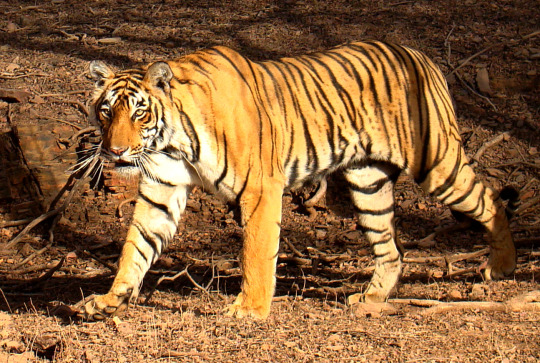
Human-caused biodiversity loss is a global problem, large carnivores are particularly threatened, and the tiger (Panthera tigris) is among the world’s most endangered large carnivores. The South China tiger (Panthera tigris amoyensis) is the most critically endangered tiger subspecies and is considered functionally extinct in the wild
The tigers live in a wide variety of habitats, suggested by their distribution across a wide range of ecological conditions. They are known to occur in tropical lowland evergreen forest, monsoonal forest, dry thorn forest, dry oak and birch woodlands, tall grass jungles, and mangrove swamps. They are able to cope up with a broad change of climatic variation, from warm moist areas, to areas of extreme snowfall.
Reintroduction is the way on how they are going to prevent the endangered species the Panthera Tigris. What is Reintroduction? Reintroduction is a potential benefit for individual species or for broader ecosystem function. Intertwined with such benefits are related motivations or outcomes that can span aesthetic, sociological, cultural, political, or economic aspects. These in turn may differ according to species, scale, and economic context.
The government of China, together with the leaders of tiger range countries, recently declared a goal to double the world’s wild tiger population by 2022. Due to the growing awareness of the importance of tiger reintroduction as one strategy to support tiger recovery goals, Chinese authorities and international organizations are seeking to identify one or more existing protected areas of sufficient size within the historical range of South China tigers to support wild tiger populations. This would be the world’s first large-scale reintroduction of captive tigers back to the wild.
A free-ranging population of 15–20 tigers living in a minimum of 1000 km2 of habitat was identified as a target. The government assessed summer and winter habitat suitability of two critical prey species, wild boar (Sus scrofa) and Sika deer (Cervus nippon), using GIS spatial models to evaluate the potential for tiger reintroduction in one likely candidate site.
They identify major challenges facing a potential tiger reintroduction project and conclude that restoring the habitat and prey base, addressing concerns of local people, and enhancing coordination across park boundaries are significant challenges to meeting the broader goals of supporting a reintroduced wild tiger population.
Habitat Regions: temperate, tropical, terrestrial.
Terrestrial Biomes: tundra, taiga, savanna or grassland, forest, rainforest, scrub forest, mountains.
Wetlands: Marsh-are wetland areas often dominated by grasses and reeds.
Ailuropoda melanoleuca
Ailuropoda melanoleuca also known as the panda bear or simply the panda, is a bear native to south central China. It is characterised by large, black patches around its eyes, over the ears, and across its round body, the giant panda is one of the most beloved animals in the world.

Furs: They were hunted for their valuable furs. Poaching has declined in recent years, due to new laws and greater public awareness of conservation efforts. Perhaps more critically, destruction of their native forests destroyed much of the bamboo pandas relied upon to survive. Pandas face a lot of dangers, but zoos and panda reserves are doing everything they can to keep them from becoming extinct.
Habitat Loss: By far, the greatest threat facing wild pandas, and the biggest reason they are critically endangered today, is deforestation on the part of humans, which has led to permanent habitat loss in some areas. Wild pandas once roamed bamboo forests in China, Vietnam, Laos and Burma. Today, wild pandas are found only in China, and in far fewer numbers than ever before. Scientists estimate that there are only around 1,800 wild pandas alive today. Habitat loss spells certain doom for pandas. If a bamboo forest is cleared away, then the pandas' food source is gone. Relocating to another forest is often impossible, as forests today have become separated from one another, thanks to human cities and towns. Without access to a steady source of bamboo, pandas whose forests are cleared will perish from starvation.
Difficulties Adapting: Some animals have found ways to adapt to human activity in areas that were once wild. For example, raccoons once lived primarily in forests but now inhabit many cities and towns, eating discarded food left behind by people. Raccoons are able to adapt in this way because of their physical attributes, such as their digestive systems, which can digest nearly any kind of food, and their small size, which allows them to hide easily. There are other animals, such as pigeons and rats, that have adapted in similar ways to live alongside humans.Pandas have no such adaptations. They cannot simply move into cities and towns when their forests are destroyed, mainly because they are so specifically adapted to a life of eating bamboo. Pandas' digestive systems can't properly digest anything else. Because bamboo shoots and leaves don't contain many nutrients, pandas also must consume vast quantities of it – around 20 to 40 pounds a day. Even if pandas could eat something other than bamboo, pandas could never blend in safely in cities or towns, due to their large size. For pandas, the environment they originally adapted to is the only environment where they can thrive.
Difficulties Reproducing: Even in captivity, breeding pandas is notoriously difficult. Pandas are extremely selective about choosing their mates, which means that even if a male and female panda are kept in the same enclosure for years, there is no guarantee the pair will mate. If pandas do mate in captivity, the cubs often need to be hand-raised by people, since captivity seems to throw off the maternal instincts of many panda mothers, causing them to abandon or even harm their cubs. Because of these issues, conservation programs that release pandas into the wild, in order to increase their numbers.
1 note
·
View note
Text
Top 9 subspecii de tigru de pe Terra. Trei dintre ele au dispărut deja
Evoluția a făcut că oamenii să fie contemporani cu nouă specii de tigri, unele dintre acestea au dispărut în decursul ultimului secol.
Tigrii sunt unele dintre cele mai cunoscute feline la nivel global, culorile acestora captând imaginația scriitorilor, dar și a fotografilor de-a lungul timpului.
Din punct de vedere științific, tigrii sunt o specie de mamifere carnivore din familia felinelor, dar și una dintre cele patru specii ale genului Panthera. Oamenii de știință explică faptul că aceste feline sunt unele dintre cei mai mari prădători tereștri, culorile lor fiind adaptate mediului în care au evoluat.
Studiile și observațiile oamenilor de știință au dus la concluzia că tigrii pot fi împărțiți în nouă subspecii, acestea diferențiindu-se prin modul în care sunt dispuse dungile lor. În prezent mai spravieșuit doar șase subspecii, celelalte trei dispărând odată cu scăderea populației generale de tigri. Live Science a creat o listă cu aceste subspecii.
9. Tigrul de Sumatra
Numele științifici al acestei subspecii aceste acela de Panthera tigris sumatrae și după cum sugerează acești tigri pot fi întâlniți pe insula Sumatra. Aceasta este singura subspecie de tigru care a reușit să supraviețuiască în regiune, celelalte două fiind dispărute de câteva decenii.
Analizele genetice indică faptul că aceștia au un ADN diferit față de cel al speciilor de pe continentul asiatic. Tigrul de Sumatra persistă în populații mici și fragmentate de-a lungul insulei, în pădurea de la nivelul mării aflată pe coasta joasă a Parcului Național Bukit Barisan Selatan, în zona de sud-est a provinciei Lampung sau în pădurile de munte ale Parcului Național Gunung Leuser.
8. Tigrul siberian
Panthera tigris tigris, este cea mai mare subspecie de tigru și își are habitatul în Siberia, nord-estul Chinei și după cum speculează unii cercetători, chiar și în Coreea de Nord.
Masculii pot atinge până la 3,3 m de la cap până la coadă și cântăresc până la 300 de kilograme. Femelele sunt mai mici, atingând doar 2,6 m în lungime și aproximativ 100 până la 167 kilograme în greutate.
7. Tigrul indian
Această subspecie mai este numită și tigrul de Bengal și după cum sugerează numele populează subcontinentul indian. Unele ONG-uri estimează că în India trăiesc până în 4.000 de indivizi ai aceste subspecii.
În timp ce majoritatea tigrilor de Bengal au o colorație obișnuită pentru specia lor, o genă recesivă face ca unii să fie crem sau chiar de culoare albă în loc de portocaliu.
6. Tigrul din sudul Chinei
Panthera tigris amoyensis sunt specifici zonei de sud a Chinei și după cum explică specialiștii aceștia reprezintă o subspecie critic periclitată. Estimările sugerează existența a doar cîteva zeci de astfel de tigri în grădinile zoologice și în sălbăticie.
În urmă cu doar cinci decenii populația acestei subspecii număra cîteva mii de exemplare, dar deoarece au fost declarați dăunători, vânătorii au putut să reducă dramatic efectivele acestora.
5. Tigrul malaezian
Cercetătorii numesc această subspecie Panthera tigris jacksoni, iar identificarea acesteia a avut recent, în anul 2004. Acest tigru poate fi întâlnit în pădurile tropicale și subtropicale foioase din vârful sudic al Thailandei și Malaeziei peninsulare.
Această subspecie fost numită pentru a-l omagia pe Peter Jackson, jurnalist și conservaționist britanic, implicat activ în eforturile de salvare a tigrilor.
4. Tigrul indo-chinez
Panthera tigris corbetti sau tigrul indo-chinez este numit după vânătorul și jurnalistul britanic Jim Corbett și își are arealul în Cambodia, Laos, Burma, Thailand, și Vietnam. În urmă cu câteva decenii acest tigru putea fi identificat și pe teritoriul Chinei.
3. Tigrul de Bali
Una dintre cele trei subspecii de tigru dispărute, tigrul de Bali ultimele exemplare murind anii 1940, potrivit ONG-ului Salvați Tigrii. Această specie a fost numită de către cercetători Panthera tigris balica, iar extincția acesteia poate fi pusă pe seama mai multor cauze, printre care se numără vânătoarea, reducerea habitatelor și a prăzilor.
2. Tigrul de Java
Panthera tigris sondaica a dispărut în urmă cu patru decenii, ultimele exemplare murind în captivitate, în parcul național Meru Betiri în anul 1976. Totuși, dispariția acestora din sălbăticie a fost mai timpurie, în jurul anului 1940.
1. Tigrul caspic
Această specie de tigru a dispărut din salbaticie în jurul anilor 1970 din cauza reducerii habitatelor și a surselor de hrană.
Panthera tigris virgata a trăit din estul Turciei, nordul Iranului, Mesopotamia, Caucaz în jurul Mării Caspice, prin Asia Centrală până la nordul Afganistanului și al deșertului Xinjiang, aflat în vestul Chinei.
Citește și:
Imagini nemaivăzute de 85 de ani cu enigmaticul tigru tasmanian. VIDEO
Puiul de tigru ”Covid”, raza de speranţă de la o grădină zoologică din Mexic
China va permite din nou comercializarea produselor din oase de tigru şi coarne de rinocer
Modul de gândire al unui tigru şi principiile lui de viaţă vă pot ajuta să începeţi o săptămână corect
Articolul Top 9 subspecii de tigru de pe Terra. Trei dintre ele au dispărut deja apare prima dată în Descopera.ro.
0 notes
Photo

Inktober 2017 | Day 27 - Panthera tigris amoyensis - - "Ancestor to all tigers, driven to the brink of extinction, the South China tiger struggles to recover from from various threats. There are few if any in the wild, with the last confirmed sightings over two decades ago. There are currently about 100 in captivity - most are in Chinese zoos and breeding centers. The effects of uncontrolled hunting were compounded by extensive deforestation, reduction in available and large-scale relocations of urban populations to rural locations leading to fragmentation of tiger populations." - Save China's Tigers - - See what you can do at savechinastigers.org - - - - - - - #myart #original #art #inktober2017 #inktober #inktober17 #ink #traditional #traditionalart #fineliners #pantheratigrisamoyensis #southchinatiger #tiger #bigcats #cats #asia #china #endangeredspecies #criticallyendangered #nature #animals #environment #important #motherearth #wildlife #issues #habitatloss #illegalhunting #mammals
1 note
·
View note
Photo

For International Tiger Day, a Bengal tiger (Panthera tigris tigris). I was hoping to do a South Chinese tiger (P. tigris amoyensis), but as the most critically endangered subspecies (with no sightings since the '70s, they are potentially extinct in the wild), it's quite hard to find a good reference for them. Instead, I've drawn the first tiger species I ever saw and the big cat that started my lifelong obsession with all of the pantherids. A hundred years ago, there were 100 000 tigers throughout Asia. Of the nine subspecies, three are now extinct. Today, there are less than 4000 individuals left, although estimates show that tiger numbers have been on the rise since 2010. However, they still face challenges in the form of poaching, tiger farms and general habitat loss/fragmentation. Goals have been set to double the populations by 2022 through a project called Tx2. There are heaps of conservation programs for these incredible cats, and I would highly recommend donating or symbolically adopting if you can. Every little bit helps. Adopt a tiger at WWF: https://tinyurl.com/y99t3oh4 Donate to the Panthera Organisation:https://www.panthera.org/donate Sponsor a tiger through the Wildlife Alliance: https://www.wildlifealliance.org/tiger
2 notes
·
View notes
Photo

“South China Tiger”
(Panthera tigris amoyensis)
Ink and watercolor on paper. 2017
#tiger#ink#watercolor#wildlife#conservation#Critically Endangered Species#scientific illustration#Illustration#feline#animals#animal illustration#art
4 notes
·
View notes
Note
Hi im here about the bobcat and lynx thing. How are they same thing? Like im not completely doubting you but they look nothing alike?
That’s what I thought!
But apparently a bobcat is a subspecies of Lynx, of which there are four. The Canadian Lynx, The Eurasian Lynx, The Spanish/Iberian Lynx and apparently The Bobcat! There’s also subspecies of some of these subspecies, but we’re gonna ignore that. You can always tell the immediate difference between a Lynx and a Bobcat by their ears, because the first three (sub?)species of Lynx have black tufts on their ears. I guess they may not be the same thing so much as the same Genus: Lynx.
Similar to Tigers, though tigers are Genus: Panthera (like Lions, Jaguars, Leopards and Snow Leopards) but they are the Species: Tigris. So all the subspecies of Tigers are Tigers, though they belong to the “Large Cat” family. Which is how the Lynx and the Bobcat are the same technical breed because they’re Genus: Lynx, but different Species: Lynx (Eurasian lynx), Pardinus (Spanish lynx), Canadensis (Canadian lynx), Rufus (Bobcat). Which is really just a scientific descriptor difference, because the subspecies of Tigers have added subset monikers (i.e. tigris, sumatrae, amoyensis, altaica,jacksoni,corbetti).
This is how I understand it, so I could be totally wrong which I probably am so the only thing I can tell you with certainty is that they are part of the Felidae family.
#themostunoriginalpersonever#thanks for asking this it made me do more research#im probably wrong if we're honest#ref#in case i ever need this knowledge again
3 notes
·
View notes
Text
“No one knows how, in 1942, a tiger came to be on Hong Kong Island. Some argued it was a circus escapee, freed during the Japanese invasion when a bomb blasted a hole through its paddock. Others pointed out that it might simply have swam across Victoria Harbor from mainland China. It wouldn’t have been the first: tigers were a rarity in twentieth-century Hong Kong, but hardly the stuff of fiction.
However it got to Hong Kong Island, it never got off. Police shot the young male dead, its fulsome orange-striped body reduced to a ratty gray skin that still hangs in Tin Hau temple. In the decades since, the South China tiger (Panthera tigris amoyensis) has become one of the world’s most endangered animals.
Tigers had always been an occasional—if potent—presence in the New Territories, a large swath of the mainland and several islands adjoining China’s Pearl River Delta. It was not so long ago when, in 1915—after being dispatched to investigate what were thought to be spurious local reports—British policeman Ernest Goucher and Indian constable Ruttan Singh were mauled to death by one such cat near Fanling. Unconfirmed accounts of (and injuries by) tigers continued into the mid-twentieth century, when, in an all-too-common refrain, the animal faded into memory.
Before the 1950s, some four thousand tigers roamed throughout southern China’s provinces—more than the total number of wild tigers, of all subspecies, alive today. Then, during the Great Leap Forward, China’s havoc-wreaking industrialization campaign, tigers were declared a “pest” and their numbers plummeted. Those that straggled on into the later twentieth century were picked off by poachers capitalizing on an increasingly lucrative trade in tiger skins and bones, which to this day are flaunted as status symbols and used in traditional medicines.
The South China tiger may not be gone yet—a confirmed sighting in 2007, in the northern Shaanxi province, offers some hope that a healthy wild population might be restored. But in Hong Kong, where I live, tigers are gone.
I think about them sometimes, returning home alone and at night. A ten-minute walk from the train and the world of concrete ends abruptly in a narrow, pedestrian-only path, which skirts the edge of a marsh and winds through a clutch of bamboo forest. Dense and laced with jungle creepers, humming with insect life—in times past, it offered ideal concealment for a big, hungry cat. So maybe, if only for my own sake, I shouldn’t miss them.
I do anyway. We so often gauge nature’s vitality by the presence of outsized, charismatic species like tigers, the kind that lend themselves easily to children’s book illustrations and magazine covers. These animals are emblems of all the other life, from tiger- to insect-sized, that is no longer here. Absence is perhaps the most common condition of the Anthropocene, this epoch in which humans have irrevocably altered the face and future of the planet. In urban and undeveloped environments alike, we are haunted by a spectral presence of vanished nature: those organisms that, because of us and despite us, aren’t coming back.” - Sean P. Smith, “Ghost Tigers: Climate Change and the Escalation of Extinction.” Guernica, March 21, 2018.
#ghost tigers#climate change#extinction#tigers#hong kong#anthropocene#the end times#preparation for the end times#absence#environmental mourning#grief of loss#mass extinction
0 notes
Text
Tốt hay không khi Trung Quốc mang DNA động vật lên vũ trụ bảo tồn?
Theo thống kê năm 2017, số lượng hổ Hoa Nam Trung Quốc (Panthera tigris amoyensis) chỉ còn khoảng 165 con. Chính quyền Trung Quốc đã mang DNA hổ Hoa Nam đi bảo tồn trên không gian vũ trụ, theo Sohu.
Tuy nhiên, động thái này được người dân Trung Quốc cho là không chỉ vô dụng, mà còn gia tăng rác thải ở không gian vũ trụ, theo Liberty Time Nets.
Theo "China News", Văn phòng Quản lý Sở thú Quảng Châu nói rằng ngoài DNA của hổ Hoa Nam có tên "Kang Kang" trong công viên, còn có gen di truyền của các loài vật quý hiếm và quan trọng khác như khỉ vàng, Vượn Skywalker hoolock, địa lan, lúa nước, đậu tương, tam thất, bồ công anh, v.v, gần đây đã được Tên lửa chuyển tải số 11 đưa vào không gian vũ trụ.
Tuy nhiên, theo các nhà khoa học, các tia vũ trụ trong không gian có thể gây ra thiệt hại cho vật liệu di truyền và chi phí phục hồi các DNA này là quá cao, hơn nữa, độ bền của vật chứa các DNA cũng đáng lo ngại, và cư dân mạng nhận định rằng, làm như thế cũng đồng nghĩa với việc gia tăng lượng rác thải trong vũ trụ.
Cẩm Tiên
from Đại Kỷ Nguyên - Feed - http://bit.ly/2rXXgrc via IFTTT
0 notes
Text
Tốt hay không khi Trung Quốc mang DNA động vật lên vũ trụ bảo tồn?
Theo thống kê năm 2017, số lượng hổ Hoa Nam Trung Quốc (Panthera tigris amoyensis) chỉ còn khoảng 165 con. Chính quyền Trung Quốc đã mang DNA hổ Hoa Nam đi bảo tồn trên không gian vũ trụ, theo Sohu.
Tuy nhiên, động thái này được người dân Trung Quốc cho là không chỉ vô dụng, mà còn gia tăng rác thải ở không gian vũ trụ, theo Liberty Time Nets.
Theo “China News”, Văn phòng Quản lý Sở thú Quảng Châu nói rằng ngoài DNA của hổ Hoa Nam có tên “Kang Kang” trong công viên, còn có gen di truyền của các loài vật quý hiếm và quan trọng khác như khỉ vàng, Vượn Skywalker hoolock, địa lan, lúa nước, đậu tương, tam thất, bồ công anh, v.v, gần đây đã được Tên lửa chuyển tải số 11 đưa vào không gian vũ trụ.
Tuy nhiên, theo các nhà khoa học, các tia vũ trụ trong không gian có thể gây ra thiệt hại cho vật liệu di truyền và chi phí phục hồi các DNA này là quá cao, hơn nữa, độ bền của vật chứa các DNA cũng đáng lo ngại, và cư dân mạng nhận định rằng, làm như thế cũng đồng nghĩa với việc gia tăng lượng rác thải trong vũ trụ.
Cẩm Tiên
from Đại Kỷ Nguyên - Feed - http://bit.ly/2rXXgrc via http://bit.ly/2rXXgrc https://www.dkn.tv from Đại Kỷ Nguyên http://bit.ly/2SpsbbB via IFTTT
0 notes